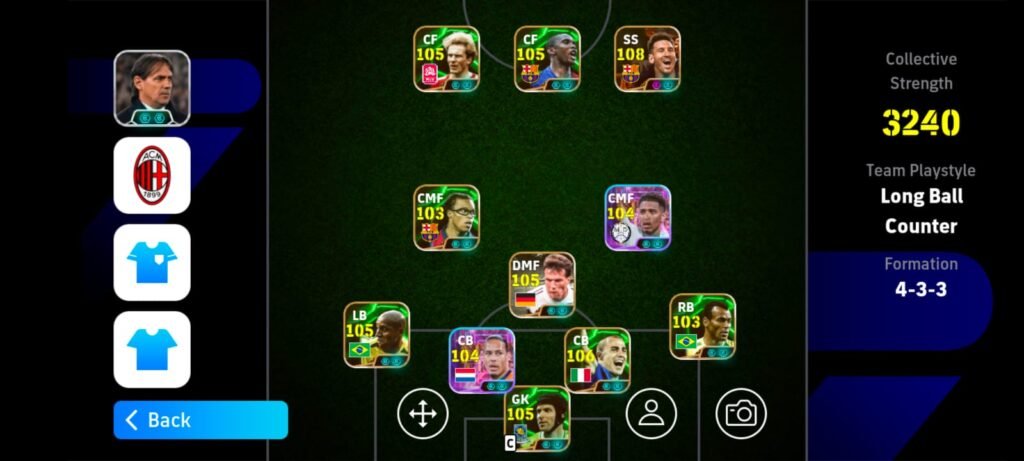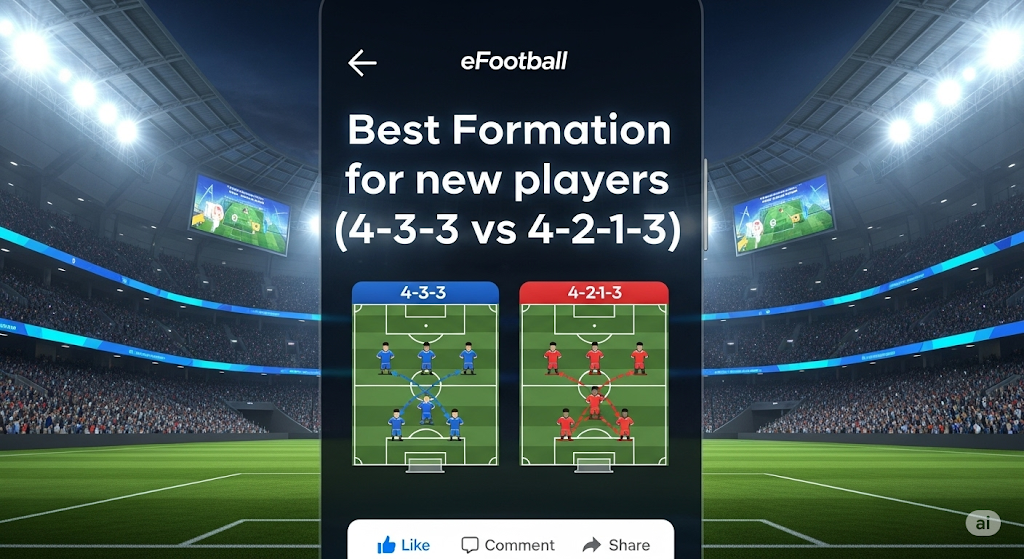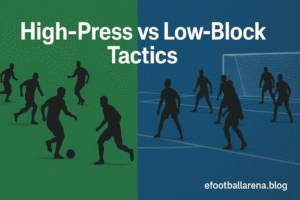
For newcomers to the exciting world of eFootball Mobile, stepping onto the virtual pitch for the first time can be both exhilarating and a little overwhelming. Beyond mastering player controls and understanding game mechanics, one of the most crucial early decisions revolves around your team’s formation. The right formation can provide a solid tactical foundation, allowing you to maximize your players’ strengths and effectively challenge opponents. Conversely, choosing a formation that doesn’t suit your playstyle or your squad can lead to frustrating defeats.
Among the plethora of formations available in eFootball Mobile, two stand out as particularly popular and effective choices for beginners: the classic 4-3-3 and the slightly more advanced 4-2-1-3. Both offer a balanced approach to attack and defense, making them excellent starting points for learning the nuances of tactical gameplay. In this comprehensive guide, we’ll delve deep into the intricacies of each formation, comparing their strengths, weaknesses, ideal player profiles, and tactical considerations to help you determine which one best suits your initial journey in eFootball Mobile.
Understanding the Basics: Formations for eFootball Numbers Explained
Before we dive into the specifics of each formation, let’s briefly clarify what the numerical representation (e.g., 4-3-3) actually means. These numbers indicate the number of players in each outfield line, starting from the back (defense) to the front (attack). So, a 4-3-3 formation consists of:
- 4 Defenders: Typically two Center Backs (CB), a Left Back (LB), and a Right Back (RB).
- 3 Midfielders: This can vary but often includes a Defensive Midfielder (DMF), and two Central Midfielders (CMF) or an attacking midfielder (AMF) alongside a CMF.
- 3 Forwards: Usually a Center Forward (CF) flanked by two Wingers (LWF and RWF) or Left Forward (LF) and Right Forward (RF).
Similarly, a 4-2-1-3 formation comprises:
- 4 Defenders: Again, usually two CBs, one LB, and one RB.
- 2 Defensive Midfielders (DMF): Two holding midfielders positioned in front of the defense.
- 1 Attacking Midfielder (AMF): A creative player positioned between the midfield and the attack.
- 3 Forwards: Similar to the 4-3-3, often a CF with two wingers (LWF/RWF or LF/RF).
Understanding these basic structures is the first step towards appreciating the tactical implications of each formation.

The Classic Balance of the 4-3-3
The 4-3-3 is a cornerstone of modern football, renowned for its balance, versatility, and ability to control possession. It provides a solid defensive structure with four players at the back, while the three midfielders offer a platform for both shielding the defense and launching attacks. The three forwards provide width and a central threat, stretching the opponent’s defense.
Strengths of the 4-3-3:
- Solid Defensive Base: The four defenders offer good coverage across the backline, making it difficult for opponents to break through easily. The presence of at least one deeper-lying midfielder (DMF) further strengthens the defensive shield.
- Balanced Midfield: The three midfielders can be configured in various ways to achieve different tactical goals. You can opt for a more defensive setup with a dedicated DMF and two box-to-box CMs, or a more attacking approach with an AMF alongside two deeper midfielders. This flexibility allows you to adapt to different opponents and game situations.
- Width in Attack: The two wingers provide crucial width in the attacking third, stretching the opponent’s defense and creating opportunities for crosses into the box or cutbacks for onrushing midfielders.
- Pressing Potential: The front three and the advanced midfielder (if you choose that configuration) can effectively press the opponent’s defense high up the pitch, aiming to win back possession in dangerous areas.
- Good for Possession-Based Play: The midfield three can work together to circulate the ball, control the tempo of the game, and patiently build up attacks.
Weaknesses of the 4-3-3:
- Can Be Susceptible to Counter-Attacks Through the Middle: If the midfielders are caught too high up the pitch, the central areas can become vulnerable to quick counter-attacks. A disciplined DMF is crucial to mitigate this risk.
- Wingers Can Become Isolated: If the midfielders don’t provide adequate support, the wingers can become isolated on the flanks, making it difficult to create meaningful attacking opportunities.
- Requires Disciplined Full-Backs: The full-backs need to balance their defensive duties with providing width in attack. If they push too high without adequate cover, it can leave space for the opponent’s wingers to exploit.
Ideal Player Types for the 4-3-3:
- Center Backs (CB): Solid defenders with good tackling, aerial ability, and positioning are essential. A mix of a more aggressive, ball-winning defender and a more composed, ball-playing defender can be beneficial.
- Full-Backs (LB/RB): Players with good speed, stamina, and defensive awareness are needed. They should also possess decent crossing ability if you intend to utilize them in attacking phases. Overlapping full-backs can add another dimension to your attack.
- Defensive Midfielder (DMF): A crucial role in the 4-3-3. The DMF should be a strong tackler, good at intercepting passes, and possess the positional discipline to shield the defense. An “Anchor Man” or “Destroyer” Player Style can be very effective here.
- Central Midfielders (CMF): Versatile players who can contribute both defensively and offensively are ideal. Look for players with good passing range, dribbling skills, and stamina. “Box-to-Box” or “Orchestrator” Player Styles can thrive in these roles. If using an AMF, prioritize creativity, passing, and shooting ability. A “Hole Player” or “Creative Playmaker” can excel in the advanced midfield role.
- Center Forward (CF): A strong and clinical finisher is paramount. Depending on your playstyle, you might prefer a target man with good aerial ability or a faster, more agile forward who can run in behind the defense.
- Wingers (LWF/RWF): Pace, dribbling skills, and good crossing or finishing ability are key attributes for wingers in a 4-3-3. “Prolific Wingers” or “Speed Dribblers” can be very effective in these wide areas.
Tactical Instructions for the 4-3-3:
- Defensive Style: Consider “Defensive” to maintain a compact shape or “Aggressive” to win the ball back higher up.
- Build-up: “Short Passing” can help maintain possession, while “Long Ball” can be effective for quick transitions.
- Attacking Area: “Wide” will utilize your wingers, while “Central” will focus on playing through the middle.
- Positioning: “Maintain Formation” offers stability, while “Flexible” allows for more fluid movement.
- Defensive Engagement: “Frontline Pressure” can be effective for winning the ball back high, while “Deep Line” provides more defensive solidity.
Experiment with these instructions to find a setup that complements your players and your preferred style of play.
The Attacking Flair of the 4-2-1-3
The 4-2-1-3 is a more attacking variation that builds upon a solid defensive foundation. The two defensive midfielders provide excellent protection to the back four, while the single attacking midfielder acts as a crucial link between midfield and attack, providing creativity and through balls for the three forwards.
Strengths of the 4-2-1-3:
- Strong Central Defense: The double pivot of two defensive midfielders offers exceptional protection to the central areas, making it difficult for opponents to penetrate through the middle.
- Creative Hub in the Attacking Midfielder: The AMF acts as a focal point for attacks, capable of creating chances with incisive passes, clever dribbling, and well-timed runs into the box.
- Multiple Attacking Threats: The three forwards, supported by the AMF, can overload the opponent’s defense, creating numerous scoring opportunities.
- Good for Quick Transitions: The two DMFs can win the ball back and quickly feed it to the AMF, who can then release the forwards on fast counter-attacks.
- Central Overload in Attack: With the AMF joining the three forwards, you can create a significant central presence in the attacking third, potentially overwhelming the opponent’s central defenders.
Weaknesses of the 4-2-1-3:
- Can Lack Width in Attack: Compared to the 4-3-3, the 4-2-1-3 can sometimes lack natural width, especially if the full-backs are more defensively oriented. Relying solely on the forwards for width can make attacks predictable.
- AMF Can Become Isolated: If the midfielders don’t provide adequate support and the forwards don’t make intelligent runs, the AMF can become isolated and struggle to influence the game.
- Susceptible to Attacks Down the Flanks: While the central defense is strong, the space between the full-backs and the defensive midfielders can be exploited by fast wingers if not properly managed.
- Requires a High-Quality AMF: The effectiveness of the 4-2-1-3 heavily relies on the quality and performance of the attacking midfielder. A weak or poorly positioned AMF can neuter the formation’s attacking potential.
Ideal Player Types for the 4-2-1-3:
- Center Backs (CB): Similar to the 4-3-3, solid defenders with good tackling, aerial ability, and positioning are crucial.
- Full-Backs (LB/RB): While defensive solidity is important, full-backs with good stamina and crossing ability can provide much-needed width in attack. “Offensive Full-Backs” can be particularly effective in this formation.
- Defensive Midfielders (DMF): Two strong and disciplined holding midfielders are essential. One can be a more aggressive “Destroyer” who focuses on winning back possession, while the other can be an “Anchor Man” who sits deeper and dictates play with accurate passing.
- Attacking Midfielder (AMF): This is a key role. You need a creative player with excellent passing, dribbling, and vision. A “Hole Player” who makes late runs into the box or a “Creative Playmaker” who can unlock defenses with intricate passes are ideal. Good shooting ability from range is also a valuable asset.
- Center Forward (CF): Similar to the 4-3-3, a clinical finisher is crucial. Consider a forward who can link up well with the AMF and make intelligent runs off the ball.
- Wingers (LWF/RWF): Pace and dribbling are essential to beat defenders in one-on-one situations. Look for wingers who can either cut inside to shoot or deliver accurate crosses into the box.
Tactical Instructions for the 4-2-1-3:
- Defensive Style: “Defensive” can provide a very solid base, while “Containment Area: Wide” can help protect against attacks down the flanks.
- Build-up: “Short Passing” can help control possession in midfield, while “Quick Counter” can utilize the pace of your forwards and the vision of your AMF.
- Attacking Area: “Central” will maximize the impact of your AMF and central forward, while “Wide” can utilize the full-backs if they have good attacking attributes.
- Positioning: “Maintain Formation” offers stability, while “Flexible” can allow your AMF to roam and find space.
- Defensive Engagement: “Deep Line” can be effective with two holding midfielders, making it difficult for opponents to penetrate centrally.
Experiment with these instructions to tailor the 4-2-1-3 to your specific players and tactical preferences.
Choosing Your Formation: Factors to Consider
Ultimately, the “best” formation for you as a new eFootball Mobile player depends on several factors:
- Your Playing Style: Do you prefer a patient, possession-based approach or a more direct, counter-attacking style? The 4-3-3 lends itself well to possession, while the 4-2-1-3 can be very effective for quick transitions.
- Your Available Players: Examine the strengths and weaknesses of your current squad. Do you have strong wingers? A creative attacking midfielder? Solid defensive midfielders? Choose a formation that allows your best players to shine in their preferred roles. Don’t try to force a formation if you don’t have the right personnel.
- Your Comfort Level: Start with the formation that feels most intuitive to you. As you gain more experience, you can experiment with different setups. The 4-3-3 is often considered a more straightforward formation for beginners due to its balanced nature.
- Your Opponent: As you become more tactically astute, you’ll start to consider your opponent’s formation and playing style when choosing your own. Some formations are more effective against others.
Tips for New Players:
- Start with a Balanced Approach: Both the 4-3-3 and 4-2-1-3 offer a good balance between attack and defense, making them excellent starting points.
- Don’t Be Afraid to Experiment: Try both formations in different matches to see which one you feel more comfortable with and which yields better results.
- Focus on Understanding the Basics: Before making drastic tactical changes, ensure you have a good grasp of player positioning and basic attacking and defending principles within your chosen formation.
- Pay Attention to Player Instructions: Individual player instructions (e.g., attacking full-backs, deep-lying forward) can further fine-tune your formation and tactical approach. Start with the default instructions and gradually experiment as you become more confident.
- Be Patient: Mastering a new formation takes time and practice. Don’t get discouraged if you don’t see immediate results. Keep learning and refining your approach.
- Watch Replays: Analyze your matches, both wins and losses, to identify what’s working and what needs improvement in your chosen formation.
Adapting Your Formation During a Match
One of the keys to success in eFootball Mobile is the ability to adapt your tactics during a match. If your initial formation isn’t working, don’t be afraid to make changes. Here are some scenarios and potential adjustments:
- If you’re struggling to break down a stubborn defense (4-3-3): Consider pushing one of your central midfielders further forward to act as an AMF, creating a 4-2-1-3 or a 4-3-1-2 diamond. You could also instruct your full-backs to overlap more frequently to provide additional width.
- If you’re being overrun in midfield (4-3-3): Drop one of your more attacking midfielders deeper to create a 4-1-4-1 or a more solid 4-3-3 with a dedicated DMF and two box-to-box midfielders.
- If you need more defensive stability (4-2-1-3): Instruct your attacking midfielder to track back and help the midfield out of possession, effectively creating a 4-3-3 or a 4-5-1. You could also switch one of your wingers to a more defensive winger or midfielder role.
- If you need more attacking firepower (4-2-1-3): Consider switching to a 4-2-2-2 with two attacking midfielders or pushing one of your defensive midfielders into a more advanced role.
Learning to read the game and make timely tactical adjustments is a crucial skill that will significantly improve your results in eFootball Mobile.
Conclusion: Finding the Right Fit for Your eFootball Journey
Choosing the right formation is a fundamental step for any new eFootball Mobile player. Both the 4-3-3 and the 4-2-1-3 offer strong foundations with their own unique strengths and weaknesses. The 4-3-3 provides a classic balance and versatility, making it a reliable choice for learning the game. The 4-2-1-3, with its strong central defense and creative attacking midfielder, offers more attacking flair but requires a good understanding of positional play.
Ultimately, the best formation for you will depend on your individual playing style, the players you have at your disposal, and your comfort level with different tactical setups. Don’t be afraid to experiment, learn from your experiences, and adapt your approach as you continue your journey in the exciting world of eFootball Mobile. With practice and a good understanding of these fundamental formations, you’ll be well on your way to building a successful virtual football team. Good luck on the virtual pitch!
Also Check The Complete Guide to Building an Out Wide Squad in eFootball 2026
Top 5 Best Formations for the Long Ball Counter Playstyle in eFootball 2026










